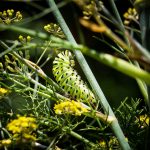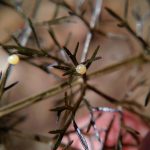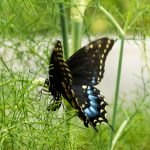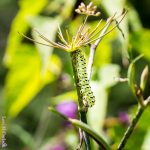Better Know a Host Plant is a series of posts all about common to rare butterfly host plants. Each week during the butterfly season we will feature a host plant that we have experience with, or just find interesting!
Common Name: Fennel
Latin Name: Foeniculum vulgare
Bloom time: June through September
Sun: Full sun to part shade
Water: Drought tolerant
Height: 2-9 feet
Spread: 3-4 feet
Native: No
Host Plant: Eastern Black Swallowtail
Nectar Plant: Attracts a variety of pollinators
Colors & Cultivars: Small, yellow flowers
Our Experience: Fennel is the primary plant we use for the Black Swallowtail. It readily self-sows so once you have it established, it will be the gift that keeps on giving. And you can never have too much! Our plants never really go fully dormant unless the winter is extremely cold. Even then the plants will start to regrow during January. Seedlings will sprout through the year. Females prefer to lay eggs on younger plants that tend to be out of the direct sun. Plants grown in over 8 hours of sun can grow monsterously tall. The plant featured in the top photo was about 9 feet in height. It was blown down during a thunderstorm. Height can be controlled by hours of sunlight provided.
Pros: Easily grown from seed and will readily self-sow. Can be grown in containers. Fennel tends to be favored for egg laying compared to other host plants. Tolerates benign neglect. Attracts unusual pollinator insects like beetles, wasps, and assorted flies.
Cons: Readily self-sows requiring a lot of removal of unwanted seedlings. Since it is our primary host plant for Black Swallowtails we don’t mind having all the extra plants.
Interesting Notes: This is not the same type of fennel used for its root. The fronds can be used in cooking and do have a licorice odor that is quite pungent when being used as a host plant for Black Swallowtail caterpillars.
Other insects will lay eggs on fennel so here are some helpful hints for making a positive identification: Black Swallowtail eggs are perfectly round and have a milky to yellowish coloration. They can be seen with the naked eye. Typically you will not see the female lay eggs as she operates under a cloud of secrecy and cover of darkness.
Rating: 4.5 out of 5




Left to right: Black Swallowtail pupa attached to fennel stalks; Black Swallowtail eggs; Female laying eggs; Late instar caterpillar who has eaten all of the fennel seeds and is now sad.
